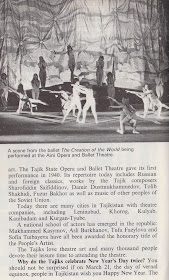Over the coming weeks we will be taking a look at these books and the republics. The books will be slightly edited for length and repetition in some cases and the photographs and illustrations will be dispersed more evenly throughout the text.
In our first post we looked at the Kirghiz SSR. Here we look at the Tajik SSR which bordered the Kirghiz and Uzbek SSRs as well as China and Afghanistan. Written by Mukhamed Asimov, the booklet touches on the ancient past of the Tajik people and the dramatic growth of its economy, educational facilities, healthcare, etc, during the Soviet era.
It also provides an interesting history of the revolutionary struggle in the region during the civil war including the fight against counter-revolutionary bands, the ouster of the final Emir in 1921 and the examples of figures like Zainabbibi Kurbanova, the first woman to head a district Soviet, who was murdered by anti-communists.
There are pages of photographs showing the people and places of Tajikistan, including sports, traditional costumes, tourism and more.
Other interesting topics include the development of the cotton industry and farming more generally, the fact that the Soviet system adapted itself to Tajik culture by decentralizing workplaces to accommodate cultural traditions, the rise of scientific institutions after the revolution, and festivals and traditions such as Gushtigiri (a sport whose winner was awarded a young lamb) and Nowruz, the Persian New Year (called Navruz here).
Also included are looks at the rise of the Tajik capital of Dushambe (or Dushanbe) from a town of 6,000 in 1926 to a metropolis of 600,000 in 1987, the importance of bazaars to Tajikistan, issues around a lack of architectural diversity reflective of traditions due to rapid urban expansion and the remarkable work of Soviet and other archaeologists at the time to investigate the Tajik past.
(Click on scans to enlarge)


























































































No comments:
Post a Comment